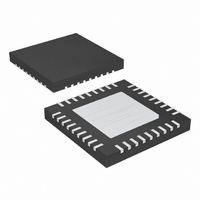MAX9742ETX+ Maxim Integrated Products, MAX9742ETX+ Datasheet - Page 20

MAX9742ETX+
Manufacturer Part Number
MAX9742ETX+
Description
IC AMP AUDIO PWR 20.5W D 36TQFN
Manufacturer
Maxim Integrated Products
Type
Class Dr
Datasheet
1.MAX9742ETX.pdf
(36 pages)
Specifications of MAX9742ETX+
Output Type
2-Channel (Stereo)
Max Output Power X Channels @ Load
20.5W x 2 @ 8 Ohm
Voltage - Supply
20 V ~ 40 V, ±10 V ~ 20 V
Features
Depop, Differential Inputs, Mute, Short-Circuit and Thermal Protection, Shutdown
Mounting Type
Surface Mount
Package / Case
36-TQFN Exposed Pad
Product
Class-D
Output Power
16 W
Thd Plus Noise
0.08 %
Supply Current
15 mA
Maximum Power Dissipation
2.86 W
Maximum Operating Temperature
+ 85 C
Mounting Style
SMD/SMT
Audio Load Resistance
4 Ohms
Minimum Operating Temperature
- 40 C
Lead Free Status / RoHS Status
Lead free / RoHS Compliant
Single-/Dual-Supply, Stereo 16W,
Class D Amplifier with Differential Inputs
To guarantee stability and minimize distortion, select
the external feedback resistor (R
(C
where f
mined by R
Frequency and Output Current Limit (R
Resistor R
(f
Set f
For example, selecting a 68kΩ resistor for R
in a switching frequency of 303kHz and an output
short-circuit current limit of 4.5A.
To prevent damage to the MAX9742 during output
short-circuit conditions and to utilize its full output
power capabilities, use resistor values greater than or
equal to 58kΩ and less than or equal to 75kΩ for R
The AC-coupling capacitors (C
(R
from an input signal (see the Typical Application
Circuits/Functional Diagrams ). C
components from the input-signal source from appear-
ing at the amplifier outputs. The -3dB point of the high-
pass filter, assuming zero source impedance due to the
input signal source, is given by:
Choose C
cy of interest. Setting f
low-frequency response. Use capacitors with low-voltage
coefficient dielectrics. Aluminum electrolytic, tantalum, or
20
SW
IN_
FB_
) and the output short-circuit current-limit value (I
SW
______________________________________________________________________________________
) form highpass filters that remove any DC bias
) so that the following conditions are met:
and I
R
SW
F_
IN
REF
is the output switching frequency deter-
f
so that f
×
SC
−
3dB
REF
determines the output switching frequency
f
C
SW
I
with the following equations:
Setting the Switching Frequency and
SC
FB_
=
(see the Setting the Switching
=
-3dB
=
≥
-3dB
3.3 s
2
3.6A
π
21.5
f
is well below the lowest frequen-
SW
µ
×
Output Current Limit (R
too high affects the amplifier’s
R
×
×
1
Input-Coupling Capacitor
and R
IN
1
68k
68k
R
R
×
REF
REF
IN
Ω
Ω
) and input resistors
IN
C
F
IN
F_
_
( )
(
prevents any DC
A
Hz
) and capacitor
>
REF
(
Hz
)
400 Ω
) section).
)
REF
k
results
REF
REF
SC
.
).
)
film dielectric capacitors are good choices for AC-cou-
pling capacitors. Capacitors with high-voltage coeffi-
cients, such as ceramics (non-C0G dielectrics), can
result in increased distortion at low frequencies.
An LC output filter is needed to extract the amplified
audio signal from the PWM output (see Figure 8). The LC
circuit forms an LCR lowpass filter (neglecting voice coil
inductance) with the impedance of the speaker. To pro-
vide a maximally flat-frequency response, the LCR filter
should be designed to have a Butterworth response and
should be optimized for a specific speaker load. Table 1
provides some recommended standard L
ponent values for 4Ω, 6Ω, and 8Ω speaker loads. The
component values given in Table 1 provide an approxi-
mate -3dB cutoff frequency (f
paragraph provides information on calculating filter com-
ponent values for cutoff frequencies other than 40kHz
and speaker loads not listed in Table 1.
The LCR filter has the following 2nd order transfer function:
where L
value of the filter capacitor, and R
tance of the speaker. The voice coil inductance of the
speaker has been neglected to simplify filter calcula-
tions (see the Zobel Network section). The above trans-
fer function is presented in the general 2nd order
transfer function format given below:
where w
the damping ratio of the 2nd order system. For an ideal
Butterworth response, ζ is equal to 0.707 and ω
equal to the -3dB cutoff frequency, ω
transfer functions and converting to Hertz, the -3dB cut-
off frequency of the filter is:
Single-Ended LC Output Filter Design (L
H
(s)
F
n
H
is the natural frequency in radians/s and ζ is
is the value of the filter inductor, C
=
(s)
s
f
=
2
C
s
+
=
2
R
+
2
SPKR
×
2
π
×
1
L
×
F
×
ζ
1
×
C
1
C
×
ω
) of 40kHz. The following
L
F
C
n
F
ω
2
F
s
×
n
SPKR
C
+
×
F
c
L
. Using the above
s
(
F
Hz
is the DC resis-
F
+
×
1
)
and C
C
ω
F
n
F
2
and C
F
F
is the
com-
C
F
is
)












